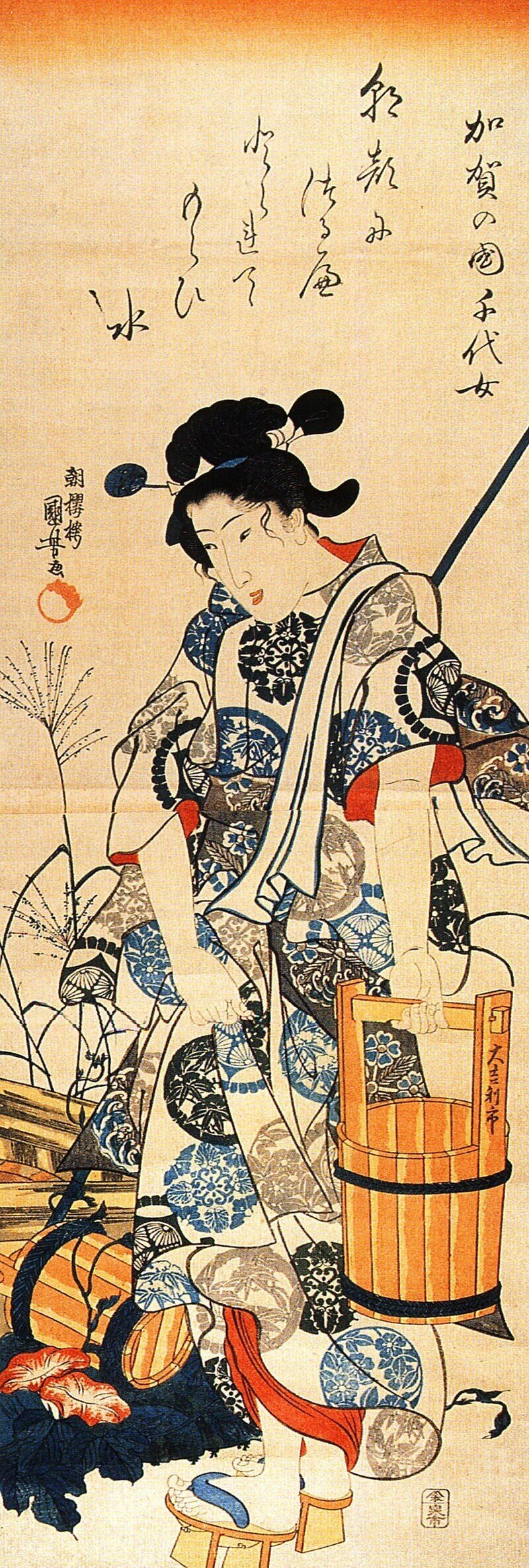
#333 AI実験_俳句の解釈 「川ばかり闇はながれて蛍かな」加賀千代女(AI解説・画像生成)
川ばかり闇はながれて蛍かな
加賀千代女
"Only the river, the darkness flows, and fireflies glow"
Kagano Chiyojo

解説:
風物詩
この俳句は日本の初夏の情景を描いています。川と蛍という二つの要素は、特にこの時期を象徴する風物詩です。蛍は日本の初夏に見られる美しい光の虫であり、川辺で蛍を鑑賞することは多くの日本人にとって懐かしく、ロマンティックな体験です。
表現手法
視覚的な対比: 「川ばかり」と「闇」という対比が鮮明です。川の流れが明確に感じられる一方で、闇が全体を包み込んでいる情景を描写しています。
移動と静止の対比: 「ながれて」と「蛍かな」の対比が、動きと静止を同時に表現しています。闇が川と共に流れている一方で、蛍はその中に静かに光っているというイメージです。
省略: 多くの情報が省略されていますが、逆に読者の想像力をかき立てます。具体的な情景描写をせずに、川の流れと蛍の光だけで全体の風景が浮かび上がるように工夫されています。
情緒や感情や情感や情念
この俳句からは、静けさと儚さが感じられます。蛍の光は一時的で儚いものであり、その光が闇の中で際立つ様子は、自然の美しさと同時にその儚さを象徴しています。また、川の流れは時間の流れを連想させ、その中で一瞬輝く蛍の姿は、人間の儚い命や瞬間の美しさを表現しているとも解釈できます。
詳細な分析
川ばかり: 川が視覚的に目立つことを強調しており、その流れが全てを支配している様子が伝わります。
闇はながれて: 闇が川と共に流れていく様子を描写しています。これは、夜の静けさと広がる闇が川の流れと一体化していることを示しています。
蛍かな: 蛍の存在を暗示していますが、その光が静かに、しかし確かにそこにあることを示しています。この「かな」は感嘆の気持ちを込めた表現であり、蛍の光に対する感動や驚きを感じさせます。
この俳句は、日本の初夏の夜の美しさと儚さを詠み、自然と人間の感情が織り交ぜられた深い情緒を表現しています。
英訳:
Explanation
Seasonal Imagery
This haiku captures a quintessential early summer scene in Japan. The river and fireflies are evocative symbols of this season. Fireflies, which emit a soft, enchanting light, are especially cherished in Japanese culture during this time, and watching them by the riverside is a nostalgic and romantic experience for many.
Poetic Devices
Visual Contrast: The juxtaposition of "only the river" and "darkness" creates a vivid contrast. While the river's flow is distinctly felt, the encompassing darkness sets the stage for the fireflies' delicate glow.
Movement and Stillness: The verbs "flows" and "glow" contrast movement with stillness. The darkness flows along with the river, while the fireflies' light remains serene and steady, highlighting their gentle presence amidst the flowing darkness.
Ellipsis: The haiku omits detailed descriptions, prompting readers to fill in the gaps with their imagination. The brief mention of the river's flow and the fireflies' glow evokes a complete scene, allowing the reader to visualize the setting fully.
Emotion and Sentiment
This haiku conveys a sense of tranquility and ephemerality. The light of the fireflies is fleeting and delicate, standing out vividly against the encompassing darkness. This contrast symbolizes the transient beauty of nature, evoking feelings of both awe and melancholy. The river's continuous flow hints at the passage of time, while the momentary glow of the fireflies reflects the fleeting beauty of life.
Detailed Analysis
Only the river: Emphasizes the river's visual dominance, suggesting its flow governs the scene.
the darkness flows: Describes how the darkness moves along with the river, merging the night’s stillness with the flowing water.
and fireflies glow: The presence of fireflies is subtly introduced, their light standing out against the flowing darkness. The use of "glow" conveys a gentle, almost magical illumination. The word "and" ties the scene together, conveying a sense of surprise and wonder at the fireflies' appearance.
This haiku beautifully portrays the serene and ephemeral nature of an early summer night, blending natural beauty with human emotion.
加賀千代女

加賀千代女(かがのちよじょ)は、江戸時代の著名な女流俳人であり、その作品は多くの人々に愛されています。彼女は1703年に加賀国(現在の石川県白山市)に生まれ、幼少期から俳句に親しみました。実家は表具師で、12歳から俳諧を学び始めたと言われています (Wikipedia) (俳句の教科書)。
代表的な句として、「朝顔に つるべ取られて もらい水」が広く知られています。この句は朝顔の蔓が井戸の釣瓶(つるべ)に絡まってしまった状況を詠んだもので、その詩情あふれる描写が高く評価されています。この句については、正岡子規が「俳句としては俗である」と批判した一方で、鈴木大拙などがその美しさを絶賛しています (Wikipedia) (Weblio)。
千代女は30歳の時に京都で俳人中川乙由と出会い、その後も画家五十嵐浚明に絵を学びました。52歳で剃髪し、「素園」と号しました。彼女は生涯で1700以上の句を詠んだとされ、その影響は地方俳壇にとどまらず、全国的な俳諧の復興にも寄与しました (俳句の教科書) (City of Hakusan)。
晩年には病に悩まされながらも、多くの名句を残しました。辞世の句「月も見て 我はこの世を かしく哉」は、彼女の人生観を象徴するものとして知られています (Wikipedia) (Weblio)。
千代女の俳句は四季折々の自然や日常の情景を巧みに捉え、感性豊かな表現で多くの人々に親しまれています。彼女の作品は、現在も石川県白山市にある「千代女の里俳句館」などで紹介されており、彼女の遺した文化遺産は今なお輝きを放ち続けています (City of Hakusan)。
六月十三日
(英訳:ChatGPT 解説: ChatGPT 画像生成:midjourney)
この記事が気に入ったらサポートをしてみませんか?
